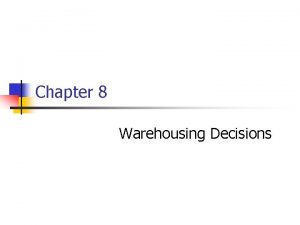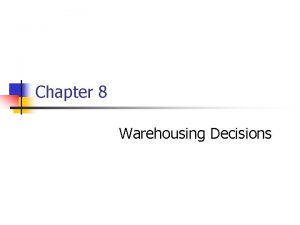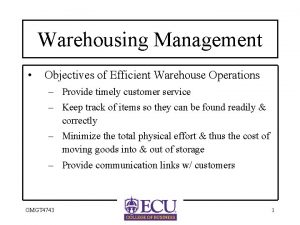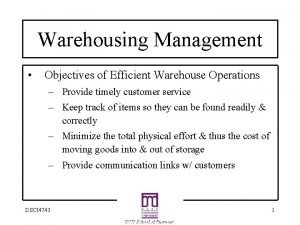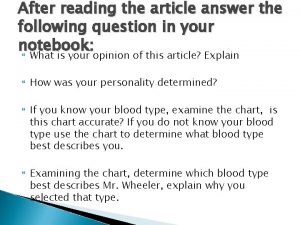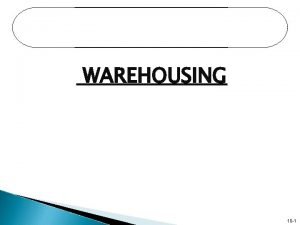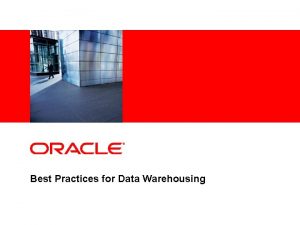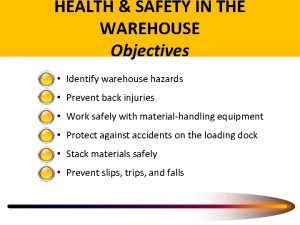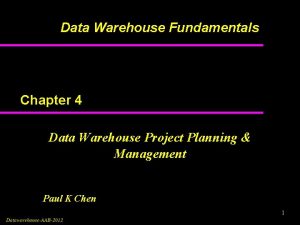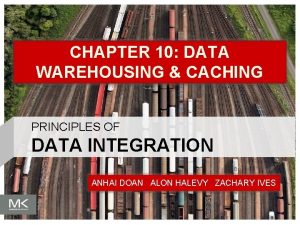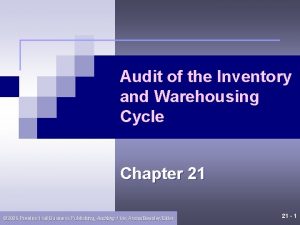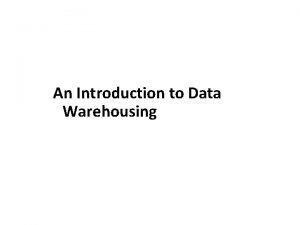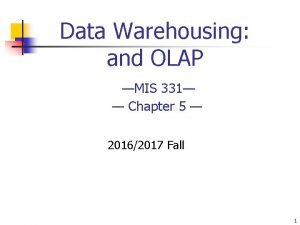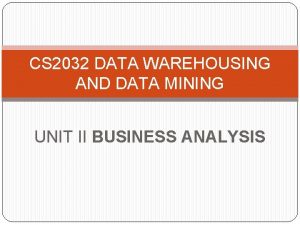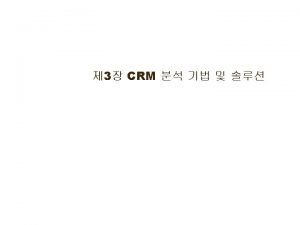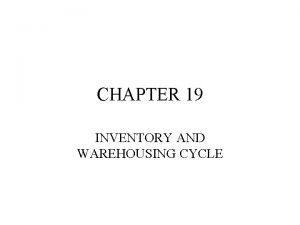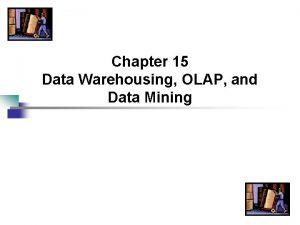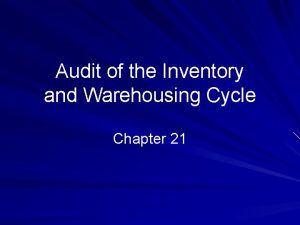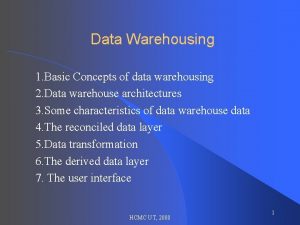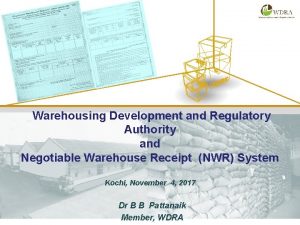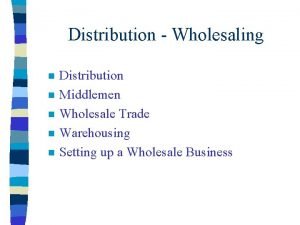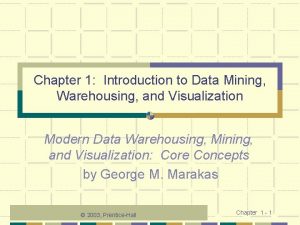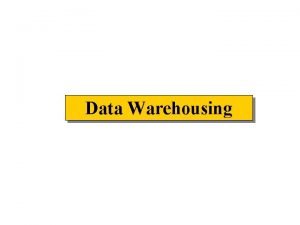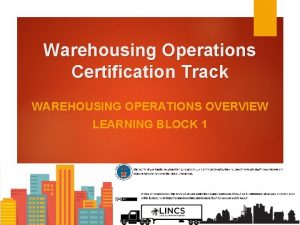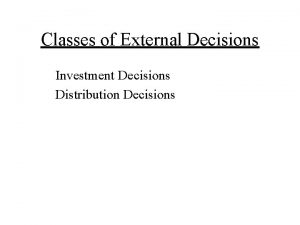Chapter 8 Warehousing Decisions Learning Objectives After reading

Chapter 8 Warehousing Decisions

Learning Objectives - After reading the chapter, you should be able to do the following: n n n Discuss the strategic value-adding role warehousing plays in the logistics system. Explain the basic rationale for warehousing in light of transportation consolidation, product mixing, service, contingency protection, and smoothing. Develop an analytical framework for basic warehousing decisions. Chapter 8 Management of Business Logistics, 7 th Ed. 2

Learning Objectives n n Distinguish between the different warehouse activities requiring space in the warehouse design. Discuss the major principles of warehouse layout design. Compare the use of private versus public warehousing. Explain public warehousing services, regulations, and pricing. Chapter 8 Management of Business Logistics, 7 th Ed. 3

Learning Objectives n n n Describe the decision-making approach used to determine the number of warehouses in the logistics system. Discuss the effect of materials handling and packaging on logistics. Describe the four dimensions and the objectives of materials handling. Chapter 8 Management of Business Logistics, 7 th Ed. 4

Learning Objectives n n n Discuss the different types of materials handling equipment and the criteria used to select this equipment. Explain the cross-functional role of packaging in a company. Discuss the role of packaging in the logistics system. Chapter 8 Management of Business Logistics, 7 th Ed. 5

Learning Objectives n n Describe the various types of packaging materials available and their relative advantages and disadvantages. Explain the rationale for using bar codes to identify packages. Chapter 8 Management of Business Logistics, 7 th Ed. 6

Logistics Profile: Grainger Industrial Supply n n n Grainger is dedicated to providing excellent customer service using an effective network of warehouses and distribution centers providing same day or next day service. 13. 6 million square feet in one national distribution center, two regional and six zone distribution centers, and 373 local branches 1. 5 million customers, 220 k SKUs, $4. 5 billion in sales, 60 k to 80 k daily customer orders Chapter 8 Management of Business Logistics, 7 th Ed. 7

The Nature and Importance of Warehousing n n n In 1999, $75 billion, or 0. 8 percent of GDP was spent on warehousing. The total supply of U. S. warehousing space in 1999 was 6. 1 billion square feet, an increase from 1990 of 700 million square feet of space. Warehousing provides time and place utility for raw materials, industrial goods, and finished products, allowing firms to use customer service as a dynamic value-adding competitive tool. Chapter 8 Management of Business Logistics, 7 th Ed. 8

The Role of the Warehouse in the Logistics System: A Basic Conceptual Rationale n n Functions of The warehouse is warehousing include: where the supply n Transportation chain holds or stores consolidation goods. n Product mixing n Cross-docking n Service n Protection against contingencies n Smoothing Chapter 8 Management of Business Logistics, 7 th Ed. 9

Table 8 -1 Warehouse Value-Adding Roles Chapter 8 Management of Business Logistics, 7 th Ed. 10

Figure 8 -1 Transportation Consolidation Chapter 8 Management of Business Logistics, 7 th Ed. 11

Figure 8 -2 Supply and Product Mixing Chapter 8 Management of Business Logistics, 7 th Ed. 12

Basic Warehouse Decisions: A Cost Trade-off Framework n n Ownership n Public versus contract versus private Centralized or Decentralized Warehousing n How many n Location n Size n Layout n What products where Chapter 8 Management of Business Logistics, 7 th Ed. 13

Figure 8 -3 Basic Warehousing Decisions Chapter 8 Management of Business Logistics, 7 th Ed. 14

The Ownership Decision n Chapter 8 Public warehousing costs mostly all variable. Private warehousing costs have a higher fixed cost component. Thus private warehousing virtually requires a high and constant volume. Management of Business Logistics, 7 th Ed. 15

The Ownership Decision n Factors to consider n Throughput volume n Stability of demand n Density of market area to be served n Security and control needs n Customer service needs n Multiple use needs of the firm Chapter 8 Management of Business Logistics, 7 th Ed. 16

Firm Characteristics Affecting the Ownership Decision Table 8 -2 Chapter 8 Management of Business Logistics, 7 th Ed. 17

Public Warehousing n n Rationale for Public Warehousing n Limited capital investment n Flexibility Public Warehousing Services n Bonded warehousing n Field warehouses Chapter 8 Management of Business Logistics, 7 th Ed. 18

Public Warehousing n Public warehousing regulation: n Liability n Receipts Chapter 8 n Public warehousing rates based upon: n Value n Fragility n Potential damage to other goods n Volume and regularity n Weight density n Services required Management of Business Logistics, 7 th Ed. 19

Contract Warehousing n n n n Up 23% per year in 2000 to $20. 4 billion. Compensation for seasonality in products. Increased geographical coverage. Ability to test new markets. Managerial expertise and dedicated resources. Less strain on the balance sheet. Possible reduction of transportation costs. Other issues discussed in Chapter 11. Chapter 8 Management of Business Logistics, 7 th Ed. 20

The Number of Warehouses n Chapter 8 Factors Affecting the Number of Warehouses n Inventory costs n Warehousing costs n Transportation costs n Cost of lost sales n Maintenance of customer service levels n Service small quantity buyers Management of Business Logistics, 7 th Ed. 21

Table 8 -3: Factors Affecting the Number of Warehouses Factor Centralized Decentralized Substitutability Low High Product Value High Low Purchase Size Large Small Special Warehousing Yes No Product Line Diverse Limited Customer Service Low High Chapter 8 Management of Business Logistics, 7 th Ed. 22

Basic Warehouse Operations n n Movement n Receiving n Put-away n Order picking n Shipping Storage n Stock location n Warehouse Management System (WMS) Chapter 8 Management of Business Logistics, 7 th Ed. 23

Figure 8 -6 Basic Warehouse Operations Chapter 8 Management of Business Logistics, 7 th Ed. 24

Figure 8 -7 The Computerized Warehouse Chapter 8 Management of Business Logistics, 7 th Ed. 25

Warehouse Layout and Design n n Chapter 8 Develop a demand forecast. Determine each item’s order quantity. Convert units into cubic footage requirements. Allow for growth. Allow for adequate aisle space for materials handling equipment. Management of Business Logistics, 7 th Ed. 26

Warehouse Layout and Design n n Provide for the transportation interface. Provide for orderpicking space. Provide storage space. Provide recouping, office, and miscellaneous spaces. Chapter 8 Management of Business Logistics, 7 th Ed. 27

Figure 8 -8 Warehouse Space Requirements Chapter 8 Management of Business Logistics, 7 th Ed. 28

Principles of Warehouse Layout Design Figure 8 -9 Chapter 8 Management of Business Logistics, 7 th Ed. 29

Warehouse Layout and Design n Chapter 8 Basic needs: n Receiving n Basic storage area n Order selection and preparation n Shipping Management of Business Logistics, 7 th Ed. 30

Warehouse Layout and Design n Layout and Design Principles: n Use one story facilities where possible. n Move goods in a straightline. n Use the most efficient materials handling equipment. n Minimize aisle space. n Use full building height. Chapter 8 Management of Business Logistics, 7 th Ed. 31

Warehouse Layout and Design: Layout and Design Objectives n n n Cubic capacity utilization Protection Efficiency Mechanization Productivity Chapter 8 Management of Business Logistics, 7 th Ed. 32

Table 8 -4: Warehouse Productivity Metrics n n n n Pounds or units per day Employees per pound moved Pounds unloaded per hour Pounds picked per hour Pounds loaded per hour Percentage of orders correctly filled Productivity ratio = pounds handled/day divided by labor hours/day Throughput = amt of material moved through the system in a given time period Chapter 8 Management of Business Logistics, 7 th Ed. 33

Materials Handling n n n Definition: Efficient short distance movement in or between buildings and a transportation agency. Four dimensions n Movement n Time n Quantity n Space Coordination Chapter 8 Management of Business Logistics, 7 th Ed. 34

Objectives of Materials Handling n n n n Increase effective capacity Minimize aisle space Reduce product handling Develop effective working conditions Reduce heavy labor Improve logistics service Reduce cost Chapter 8 Management of Business Logistics, 7 th Ed. 35

Figure 8 -12 Utilization of a Warehouse’s Cubic Capacity: Principles of Warehouse Layout Design Chapter 8 Management of Business Logistics, 7 th Ed. 36

Guidelines and Principles for Materials Handling n n To effectively plan and control materials handling, the logistics manager should recognize some guidelines and principles. Table 8 -5 lists 20 of the most commonly accepted principles of effective materials handling. Asterisks mark those deserving special attention. Chapter 8 Management of Business Logistics, 7 th Ed. 37

Table 8 -5 Principles of Materials Handling Chapter 8 Management of Business Logistics, 7 th Ed. 38

Packaging n Interest in packaging is widespread n Logistics n Warehousing n Transportation n Size n Marketing n Production n Legal Chapter 8 Management of Business Logistics, 7 th Ed. 39

The Role of Packaging n n Identify product and provide information Improve efficiency in handling and distribution Customer interface Protect product Chapter 8 Management of Business Logistics, 7 th Ed. 40

What Is Packaging? n n Consumer packaging n Marketing managers primarily concerned with how the package fits into the marketing mix. Industrial packaging n Logistics managers primarily concerned with efficient shipping characteristics including protection, ability to withstand stacking when on a pallet, cube, weight, shape and other relevant factors. Chapter 8 Management of Business Logistics, 7 th Ed. 41

Packaging Materials n n Table 8 -6 presents a comparison of various packing material characteristics. Basic considerations include: n Soft materials n Plastic n Environmental issues n Recycling (reverse logistics) Chapter 8 Management of Business Logistics, 7 th Ed. 42

Table 8 -6 Comparison of Cushioning Materials Chapter 8 Management of Business Logistics, 7 th Ed. 43

Bar Coding n n Standard markings that can be read by automatic or handheld scanners that allow for labor saving logistical activities for all supply chain members. Bar Codes contain information regarding: n Vendor n Product type n Place of manufacture n Product price Chapter 8 Management of Business Logistics, 7 th Ed. 44

Chapter 8: Summary and Review Questions Students should review their knowledge of the chapter by checking out the Summary and Study Questions for Chapter 8.

End of Chapter 8 and 8 A Slides Warehousing Decisions
- Slides: 46

